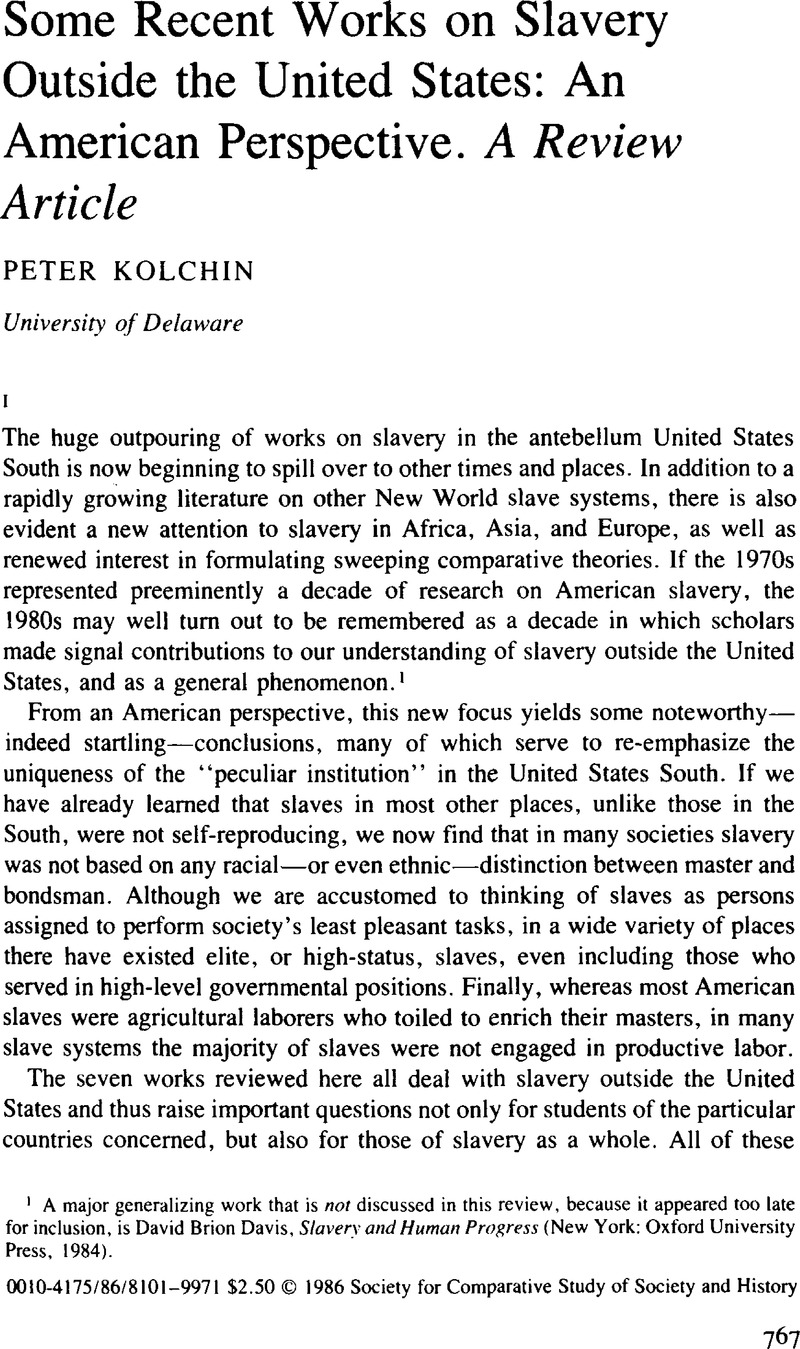Article contents
Some Recent Works on Slavery Outside the United States: An American Perspective. A Review Article
Published online by Cambridge University Press: 03 June 2009
Abstract

- Type
- Slavery and Class
- Information
- Copyright
- Copyright © Society for the Comparative Study of Society and History 1986
References
1 A major generalizing work that is not discussed in this review, because it appeared too late for inclusion, is Davis, David Brion, Slavery and Human Progress (New York: Oxford University Press, 1984).Google Scholar
2 Kopytoff, Igor and Miers, Suzanne, “African ‘Slavery’ as an Institution of Marginality,” in Slavery in Africa: Historical and Anthropological Perspectives, Miers, Suzanne and Kopytoff, Igor, eds. ([Madison:] The University of Wisconsin Press, 1977), 68;Google ScholarPatterson, Orlando, “The Structural Origin of Slavery: A Critique of the Nieboer-Domar Hypothesis from a Comparative Perspective,” in Comparative Perspectives on Slavery in New World Plantation Societies, Rubin, Vera and Tuden, Arthur, eds., in Annals of the New York Academy of Sciences, CCXCII (1977), 25, 15.Google Scholar For prominent works emphasizing the scarcity of labor as the central cause of slavery, see Nieboer, H. L., Slavery as an Industrial Syste?n: Ethnological Researches (2nd. ed., revised; The Hague: Martinus Nijhoff, 1910):Google ScholarWilliams, Eric, Capitalism and Slavery (Chapel Hill: University of North Carolina Press, 1944);Google Scholar and Domar, Evsey D., “The Causes of Slavery or Serfdom: A Hypothesis,” Journal of Economic History, XXX (1970), 18–32.Google Scholar
3 For some previous works, see Paneiakh, V. M., Kabal'noe kholopstvo na Rusi v XVI veke (Leningrad: Izdatel'stvo “Nauka,” 1967);Google ScholarPaneiakh, , Kholopstvo v XVI-nachale XVII veka (Leningrad: Izdatel'stvo “Nauka,” 1975);Google ScholarKolycheva, E. I., Kholopstvo i krepostnichestvo (konets XV-XVI v.) (Moscow: lzdatel'stvo “Nauka,” 1971);Google Scholar and Hellie, Richard, “Recent Soviet Historiography on Medieval and Early Modem Russian Slavery,” Russia, i Review, XXXV (Jan. 1976), 1–32.Google Scholar
4 Finley, Moses I., “The Idea of Slavery: Critique of David Brion Davis' The Problem of Slavery in Western Culture,” in Slavery in the New World: A Reader in Comparative History, Foner, Laura and Genovese, Eugene D., eds. (Englewood Cliffs, N.J.: Prentice-Hall, 1969), 260.Google Scholar
5 See, e.g., Pipes, Daniel, Slave Soldiers and Islam: The Genesis of a Military System (New Haven: Yale University Press, 1981).Google Scholar
6 Kopytoff and Miers, “African ‘Slavery’ as an Institution of Marginality' Herbert Le-venter, “Comments on Richard Hellie's ‘Recent Soviet Historiography on Medieval and Early Modern Slavery,’ “ Russian Review, XXXVI (Jan. 1977), 64–7;Google Scholar Richard Hellie, “A Reply.” ibid. 68–75.
7 See, e.g., Hughes, Henry, Treatise on Sociology, Theoretical and Practical (New York: Negro Universities Press, 1968; orig. pub., 1854),Google Scholarpassim; Hammond, James H., “Speech on the Admission of Kansas …, March 4, 1858,” in Selections from the Letters and Speeches of the Hon. James H. Hammond, of South Carolina (New York: John F. Trow & Co., Printers, 1866), 319;Google Scholar and Matthew, Estes, A Defence of Negro Slavery as It Exists in the United States (Montgomery, Ala.: Press of the “Alabama Journal,” 1846), 130.Google Scholar On southern discomfort with the word “slavery,” see Greenberg, Kenneth S., “Revolutionary Ideology and the Proslavery Argument: The Abolition of Slavery in Antebellum South Carolina,” Journal of Southern History, XLII (1976), 365–84.CrossRefGoogle Scholar
8 For an important case study of productive slavery in Africa, see Cooper, Frederick, Plantation Slavery on the East Coast of Africa (New Haven: Yale University Press, 1977).Google Scholar
9 On use of these sources, see Woodward, C. Vann, “History from Slave Sources,” American Historical Review, LXXIX (April, 1974), 470–81;CrossRefGoogle ScholarBlassingame, John W., “Using the Testimony of Ex-Slaves: Approaches and Problems,” Journal of Southern History, XLI (Nov. 1975), 473–92;Google ScholarRawick, George P., “General Introduction,” in The American Slave: A Composite Autobiography, Supplement Series I, Rawick, , ed. (12 vols., Westport, Conn.: Greenwood Press, 1977),Google Scholar I, ix-li; Escott, Paul D., Slavery Remembered: A Record of Twentieth-Century Slave Narratives (Chapel Hill: University of North Carolina Press, 1979), 3–17;Google ScholarBailey, David Thomas, “A Divided Prism: Two Sources of Black Testimony on Slavery,” Journal of Southern History, XLVI (Aug. 1980), 381–404.CrossRefGoogle Scholar
10 On slaves’ economic autonomy in Jamaica and St. Domingue, see Mintz, Sidney W., Caribbean Transformations (Chicago: Aldine Publishing Company, 1974), 180–206;Google ScholarMintz, , “Was the Plantation Slave a Proletarian?” Review, II (summer 1978), 92–96;Google ScholarHall, Gwendolyn Midlo, Social Control in Slave Plantation Societies: A Comparison of St. Domingue and Cuba (Baltimore: Johns Hopkins University Press, 1971), 66–68;Google Scholar and Michael, Craton, Searching for the Invisible Man: Slaves and Plantation Life in Jamaica (Cambridge. Mass.: Harvard University Press, 1978), 56, 161–62.Google Scholar For the contrast with the United States South, see Kolchin, Peter, “Reevaluating the Antebellum Slave Community: A Comparative Perspective,” Journal of American History, LXX (Dec. 1983), 588–92.Google Scholar
11 This document was first published by Schwartz, Stuart, in “Resistance and Accommodation in Eighteenth-Century Brazil: The Slaves' View of Slavery,” Hispanic American Historical Review, LVII (1977), 69–81.CrossRefGoogle Scholar
12 Peter, Kolchin, “The Process of Confrontation: Patterns of Resistance to Bondage in Nineteenth-Century Russia and the United States,” Journal of Social History, XI (1978), 459–65, 470–78.Google Scholar
13 For comparative studies of resistance, see Genovese, Eugene D., From Rebellion to Revolution: Afro-American Slave Revolts in the Making of the New World (Baton Rouge: Louisiana State University Press, 1979);Google Scholar and Kolchin, , “The Process of Confrontation.”Google Scholar
- 5
- Cited by




